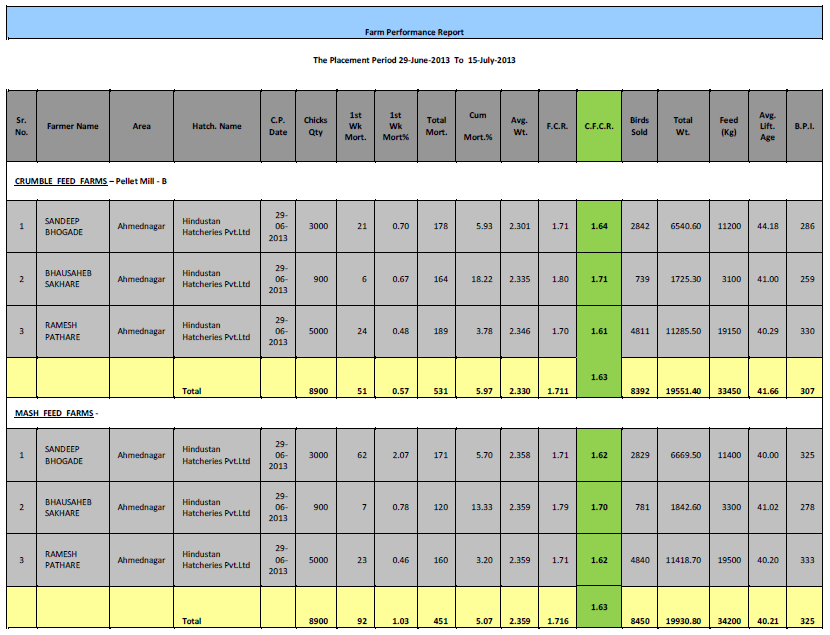Which Type of Feed is more Productive and Economical – Mash or Crumble/Pellet?
I was surprised when I saw the actual field reports under parallel trial taken on Mash Feed vs. Crumble Feed. It has been observed that everybody in the feed industry gives preference to Crumble/Pellet feed rather than Mash feed. The main reason is its better digestibility, palatability and finally better performance in terms of FCR over mash feed.
But nowadays, due to the use of high quality mixers in mash feed plants, the CV of the end product is excellent which leads to better performances on field levels. There are many pros and cons of both feed processes i.e. mash as well as Crumble/pellet. Regarding crumble/pellet feed, many people talk about the benefits of incremental energy generated during the pelletization process compared to mash feed but actual below field trial reports do not support this. According to experts, there are chances of harm to nutritional value of feed ingredients, feed additives and feed supplements in the process of pelletization if not properly handled.
Study shows that on the economical ground it’s not advisable to put the crumble/pellet mill and instead of that give preference to mash plant. For 12 Mts per hour production capacity pellet mill & mash plant, the project cost difference will be approximately around 3 Crores ( Land & machinery) and to recover this extra paid cost on pellet mill, that much benefits we are not getting from it.
To arrive at a solid conclusion, whether to put pellet mill or not, we have conducted the field trials to know the exact benefits gained.
Materials & Methods
We have selected same feed formulations with same ingredients and nutrient values for both mash and crumble feed.
To avoid the discrepancies, we have manufactured mash feed in our own feed mill and then send that feed for pelletization in 2 different renown pellet mills.
Sampling Method
Different R & D farms selected & parallel trial taken on both mash & crumble/pellet feeds.
Result
Discussions
No significant performance difference observed under trial Mash Vs Crumble/Pellet Feed.
Conclusion
As per outcome of study it’s not advisable to put a pellet mill by doing so much investment over mash plant.
Appeal
Request to readers to take such trials at your end & guide us to take a decision.
Hi, all
I am a Broiler Integrators and having Mash Feed Mill since last two decade,
There are various points which will make the Mash Feed Mill more competitive than Pellet Mill, except I do agree in Summer Season, that too when temperatures goes beyond 40 degrees.
The point to make difference is
1. Have a good quality Mash Mill (Machine) so as to compare with Pellet Mill.
2. Bad quality of Pellets r worst than mash feed.
3 Try to procure good grain crusher mill, rather than grinding mill 4.Do lot of work study to maintain the particle size.
5 Choose feed formulation wisely mean economic and performance r two different studies.
6. Instead of three type of feed choose 5 type of feed and have different grill for particle size
7. A good homework is very essential, or else consequences will be very bad.
Thanks.
All the rations in these trials contain enzymes, which are creating a revolution in Feed Technology.
My distinguished Nutritionist (from Australia) tells me that skillful use of Enzymes is making Pellet Mills obsolete in many situations. Pelleting is still useful for incorporating low grade and unpalatable ingredients, which increases profits for commercial Feedmills.
It is also well known that Enzymes are easily damaged by heat, and so at risk from the pelleting process.
In hot climates, Mash has another benefit, because most countries (except India) are using Broiler Breeds developed in Temperate climates, which are very prone to Heat Stress, and it's associated disease challenges. The slightly lower feed intake with Mash is beneficial in this case, as slower growth reduces Heat Stress, and has minimal effect on FCE.
.jpg&w=3840&q=75)

One Health - International Rendering Symposium
Please give me a mash feed formulation for meat production:
Pre starter
Starter
Finisher
For layer
Chik grower
Layer feed
Great information, using mash feed for long time. Can anyone tell how to set crude fiber in feed formulation? Like energy and protein ratio.
Pelleted feed does have some additional impacts at least for pigs that must be considered to optimize the value of the pelleting process. First, pelleted diets cause a loss of pH strata in the gut of the weaned pig and changes retention time in the stomach. This has implications for effectiveness of the stomach in barrier function against Salmonella, E. coli, etc and can lead to ulcer development. Second, temperature + moisture are catalysts for oxidation. High quality fat (low oxidation products and low oxidation potential) and ingredients with low oxidation products and low oxidation potential should be used. Third, pellet temperatures for optimal pellet quality can be in excess of the thermostability of enzymes resulting in loss of enzyme efficacy or require increased levels of enzyme inclusion. Additionally, high pelleting temperatures can cause protein folding and/or attachment of proteins to carbohydrates reducing inherent amino acid availability. A protease should be considered.
.jpg&w=3840&q=75)

One Health - International Rendering Symposium






















